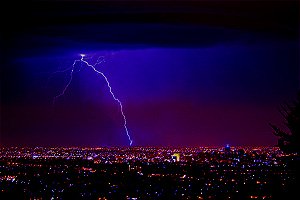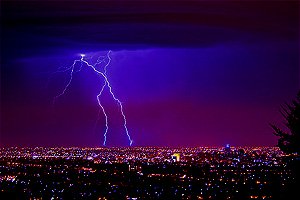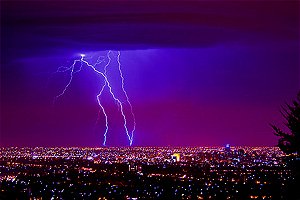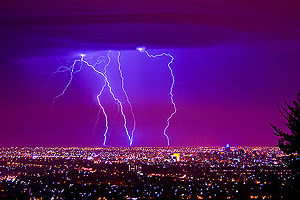How to photograph lightning
Part 2 - technique
How to photograph lightning, part 1, focussed on what you'll need. Here's where you'll learn the technique needed to photograph lightning!
How to photograph lightning - technique
Here's what you're going to do to capture those amazing bolts of lightning.- You place your camera somewhere stable, in order to avoid camera shake
- Then you watch to see where the lightning is striking
- Set the smallest aperture possible on your camera
- Open the shutter on your camera, and leave it open
- Wait until a few lightning bolts have struck ...
- ... then close the shutter.
How to photograph lightning - something stable
You need to place your camera on something stable so that you avoid camera shake. The best thing to do is to attach it to a tripod.If you haven't got a tripod you can have some success by placing the camera on a solid surface (a wall, rock...) instead.
Normally I would advise you to trip the shutter using the self timer. This is to avoid any possibility of camera shake.
However, because it will be dark, this is less important.
How to photograph lightning - watch where the lightning is
If you are a distance away from the storm (and you should be), you will see that the lightning tends to strike in pretty much the same area.It's not exactly the same spot, but in the general vicinity.
This is the area to point your camera to!
How to photograph lightning - camera settings
Once you're in position, and you can see where the lightning tends to strike, it's time to set your camera up correctly.Here's what to do:
- Zoom out to a wide angle setting. This is to give yourself the the best chance of capturing the lightning.
- Set the smallest aperture possible on your camera (something like f22). This is for two reasons - first, it will ensure everything is in focus, and, second, it means the shutter can stay open a lot longer without the image becoming over-exposed.
- Set the shutter speed for the longest you can do. Even better, if you have it, use the "B" (for "bulb") setting. This will keep the shutter open for as long as you hold your finger on the button.
How to photograph lightning - technique
OK, all set ... press the shutter button down, and wait ......wait until you see a bolt of lightning, but DON'T close the shutter yet!
Wait some more until more bolts have hit.
Once there's been a few bolts of lightning, let go of the shutter button with your finger.
(if you're using the longest exposure method, rather than the "bulb" method, set the exposure, wait, and hope that some lightning strikes while the shutter is open. If not, just try it again)
Here's what's happening ...
- While the shutter is open it will record only bright lights.
- As it's dark, the surroundings won't show up. When there's a bolt of lightning, as it's bright, it gets recorded.
- When the second bolt hits, that gets recorded too.
- And so on until you close the shutter.
- Everything else in the scene that isn't bright won't be recorded.

In this first step the camera has been placed on a tripod, and the shutter is open. One bolt of lightning strikes and is recorded on the image.

The shutter remains open to capture more lightning bolts. And sure enough, another bolt of lightning strikes and is recorded on the image.

The shutter stays open, and ... another bolt of lightning hits and gets recorded.

The shutter is still open and another bolt of lightning strikes. Finally, after a few strikes, the shutter is closed.
So there you go, how to capture lightning in a few simple steps.
It's worth reminding you at this point that your personal safety is paramount. Don't put yourself in any dangerous situations. It's great to photograph lightning, but it's not worth taking un-necessary risks to do so.
Other articles that might be worth reading:
- Understanding the aperture on your camera
- Understanding the shutter speed control on your camera
- Creative use of the shutter speed
- Night photography tips
